

Friedrich Nietzsche. Friedrich Wilhelm Nietzsche (/ˈniːtʃə/[1] or /ˈniːtʃi/;[2] German: [ˈfʁiːdʁɪç ˈvɪlhɛlm ˈniːt͡sʃə]; 15 October 1844 – 25 August 1900) was a German philosopher, cultural critic, poet, composer and Latin and Greek scholar.

Thus Spoke Zarathustra. Thus Spoke Zarathustra: A Book for All and None (German: Also sprach Zarathustra: Ein Buch für Alle und Keinen, also translated as Thus Spake Zarathustra) is a philosophical novel by German philosopher Friedrich Nietzsche, composed in four parts between 1883 and 1885. Much of the work deals with ideas such as the "eternal recurrence of the same", the parable on the "death of God", and the "prophecy" of the Übermensch, which were first introduced in The Gay Science.[1] Origins[edit] Thus Spoke Zarathustra was conceived while Nietzsche was writing The Gay Science; he made a small note, reading "6,000 feet beyond man and time," as evidence of this.[2] More specifically, this note related to the concept of the eternal recurrence, which is, by Nietzsche's admission, the central idea of Zarathustra; this idea occurred to him by a "pyramidal block of stone" on the shores of Lake Silvaplana in the Upper Engadine, a high alpine region whose valley floor is at 6,000 ft.
Synopsis[edit] Alexander Pushkin. Alexander Sergeyevich Pushkin (Russian: Алекса́ндр Серге́евич Пу́шкин, tr.
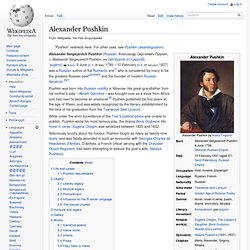
Aleksandr Sergeyevich Pushkin, IPA: [ɐlʲɪˈksandr sʲɪˈrɡʲejɪvʲɪt͡ɕ ˈpuʂkʲɪn] ( ); 6 June [O.S. 26 May] 1799 – 10 February [O.S. 29 January] 1837) was a Russian author of the Romantic era[1] who is considered by many to be the greatest Russian poet[2][3][4][5] and the founder of modern Russian literature.[6][7] Pushkin was born into Russian nobility in Moscow. His great-grandfather from his mother's side – Abram Gannibal – was brought over as a slave from Africa and had risen to become an aristocrat.[8] Pushkin published his first poem at the age of fifteen, and was widely recognized by the literary establishment by the time of his graduation from the Tsarskoye Selo Lyceum.
Notoriously touchy about his honour, Pushkin fought as many as twenty-nine duels, and was fatally wounded in such an encounter with Georges-Charles de Heeckeren d'Anthès. Life and career[edit] Georges d'Anthès Pushkin descendants[edit] Legacy[edit] Eugene Onegin. Eugene Onegin (Russian: Евге́ний Оне́гин, BGN/PCGN: Yevgeniy Onegin) is a novel in verse written by Alexander Pushkin.

It is a classic of Russian literature, and its eponymous protagonist has served as the model for a number of Russian literary heroes (so-called superfluous men). It was published in serial form between 1825 and 1832. Oscar Wilde. 19th-century Irish poet, playwright and aesthete Oscar Fingal O'Flahertie Wills Wilde (16 October 1854 – 30 November 1900) was an Irish poet and playwright.
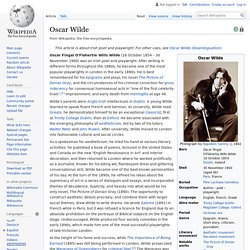
After writing in different forms throughout the 1880s, he became one of the most popular playwrights in London in the early 1890s. He is best remembered for his epigrams and plays, his novel The Picture of Dorian Gray, and the circumstances of his criminal conviction for gross indecency for consensual homosexual acts in "one of the first celebrity trials",[1] imprisonment, and early death from meningitis at age 46. Wilde's parents were Anglo-Irish intellectuals in Dublin.
A young Wilde learned to speak fluent French and German. The Picture of Dorian Gray. Novel by Oscar Wilde.
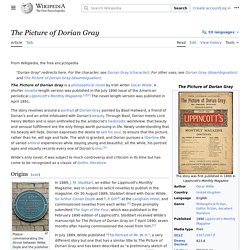
Victor Hugo. Victor Marie Hugo (French pronunciation: [viktɔʁ maʁi yɡo]; 26 February 1802 – 22 May 1885) was a French poet, novelist, and dramatist of the Romantic movement.
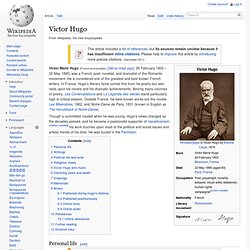
He is considered one of the greatest and best known French writers. In France, Hugo's literary fame comes first from his poetry but also rests upon his novels and his dramatic achievements. Among many volumes of poetry, Les Contemplations and La Légende des siècles stand particularly high in critical esteem. Les Misérables. Les Misérables (pronounced /leɪ ˌmɪzəˈrɑːb/; French pronunciation: [le mizeʁabl(ə)]) is a French historical novel by Victor Hugo, first published in 1862, that is considered one of the greatest novels of the 19th century.

In the English-speaking world, the novel is usually referred to by its original French title, which has not been successfully translated from French (attempts ranging from The Miserable, The Wretched, The Miserable Ones, The Poor Ones, The Wretched Poor and The Victims, to The Dispossessed).[1] Beginning in 1815 and culminating in the 1832 June Rebellion in Paris, the novel follows the lives and interactions of several characters, focusing on the struggles of ex-convict Jean Valjean and his experience of redemption.[2] The appearance of the novel was highly anticipated and advertised. Critical reactions were diverse, but most of them were negative. Commercially, the work was a great success globally. [citation needed] Novel form Digressions Hugo's sources Plot. Fyodor Dostoyevsky. The Brothers Karamazov. The Brothers Karamazov (Russian: Бра́тья Карама́зовы, Brat'ya Karamazovy, pronounced [ˈbratʲjə kərɐˈmazəvɨ]), sometimes also translated as The Karamazov Brothers, is the final novel by the Russian author Fyodor Dostoyevsky.

Dostoyevsky spent nearly two years writing The Brothers Karamazov, which was published as a serial in The Russian Messenger and completed in November 1880. The author died less than four months after its publication. Mark Twain. Samuel L.
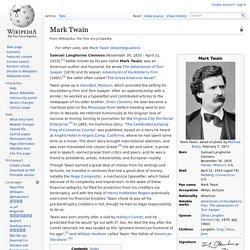
Clemens stamp, 1940 Samuel Langhorne Clemens (November 30, 1835 – April 21, 1910),[1] better known by his pen name Mark Twain, was an American author and humorist. He wrote The Adventures of Tom Sawyer (1876) and its sequel, Adventures of Huckleberry Finn (1885),[2] the latter often called "The Great American Novel". Twain grew up in Hannibal, Missouri, which provided the setting for Huckleberry Finn and Tom Sawyer.
After an apprenticeship with a printer, he worked as a typesetter and contributed articles to the newspaper of his older brother, Orion Clemens. Though Twain earned a great deal of money from his writings and lectures, he invested in ventures that lost a great deal of money, notably the Paige Compositor, a mechanical typesetter, which failed because of its complexity and imprecision. Twain was born shortly after a visit by Halley's Comet, and he predicted that he would "go out with it", too. Early life Travels. The Adventures of Tom Sawyer. The Adventures of Tom Sawyer by Mark Twain is an 1876 novel about a young boy growing up along the Mississippi River.

The story is set in the fictional town of St. Petersburg, inspired by Hannibal, Missouri, where Twain lived.[2] Summary[edit] Tom Sawyer lived with his Aunt Polly and his half-brother, Sid. Tom dirties his clothes in a fight and is made to whitewash the fence the next day, as a punishment. Tom falls in love with Becky Thatcher, a new girl in town, and persuades her to get "engaged" by kissing him. Tom, Huck, and Joe Harper run away to an island. Back in school, Tom gets himself back in Becky's favor after he nobly accepts the blame for a book she has ripped. Summer arrives, and Tom and Huck go hunting for buried treasure in a haunted house. Charles Baudelaire.
Charles Pierre Baudelaire (French: [ʃaʁl bodlɛʁ]; April 9, 1821 – August 31, 1867) was a French poet who also produced notable work as an essayist, art critic, and pioneering translator of Edgar Allan Poe. His most famous work, Les Fleurs du mal (The Flowers of Evil), expresses the changing nature of beauty in modern, industrializing Paris during the 19th century. Baudelaire's highly original style of prose-poetry influenced a whole generation of poets including Paul Verlaine, Arthur Rimbaud and Stéphane Mallarmé among many others. Les paradis artificiels. Les Paradis Artificiels (Artificial Paradises) is a book by French poet Charles Baudelaire, first published in 1860, about the state of being under the influence of opium and hashish.
Baudelaire describes the effects of the drugs and discusses the way in which they could theoretically aid mankind in reaching an "ideal" world. The text was influenced by Thomas de Quincey's Confessions of an English Opium-Eater and Suspiria de Profundis.[1] Les Fleurs du mal. The first edition of Les Fleurs du mal with author's notes.
Overview[edit] The initial publication of the book was arranged in six thematically segregated sections: The foreword to the volume, identifying Satan with the pseudonymous alchemist Hermes Trismegistus and calling boredom the worst of miseries, neatly sets the general tone of what is to follow: Si le viol, le poison, le poignard, l'incendie,N'ont pas encore brodé de leurs plaisants dessinsLe canevas banal de nos piteux destins,C'est que notre âme, hélas! N'est pas assez hardie. Alexandre Dumas. Prolific in several genres, Dumas began his career by writing plays, which were successfully produced from the first. He also wrote numerous magazine articles and travel books; his published works totaled 100,000 pages.[2] In the 1840s, Dumas founded the Théâtre Historique in Paris.
Dumas' father (general Thomas-Alexandre Davy de la Pailleterie) was born in Saint-Domingue (present-day Haiti) to a French nobleman and an enslaved African woman. His father's aristocratic rank helped young Alexandre acquire work with Louis-Philippe, Duke of Orléans. In the election of Louis-Napoléon Bonaparte in 1851, Dumas fell from favor, and left France for Belgium, where he stayed for several years. Upon leaving Belgium, Dumas moved to Russia for a few years, before going to Italy. The Count of Monte Cristo. The Count of Monte Cristo (French: Le Comte de Monte-Cristo) is an adventure novel by French author Alexandre Dumas (père) completed in 1844. Edgar Allan Poe. The Tell-Tale Heart. "The Tell-Tale Heart" is a short story by Edgar Allan Poe first published in 1843. It is told by an unnamed narrator who endeavors to convince the reader of his sanity, while describing a murder he committed.
(The victim was an old man with a filmy "vulture-eye", as the narrator calls it.) The Raven. "The Raven" depicts a mysterious raven's midnight visit to a mourning narrator, as illustrated by John Tenniel (1858). "The Raven" is a narrative poem by American writer Edgar Allan Poe. The Cask of Amontillado.